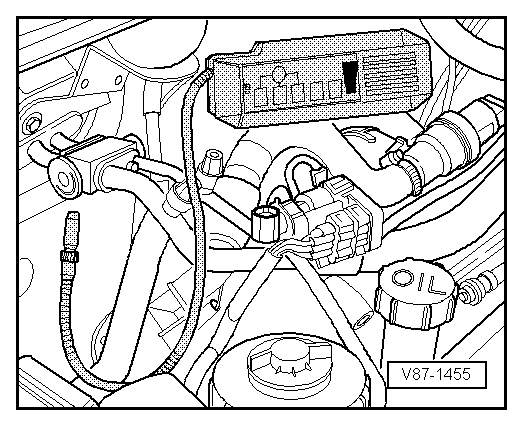Volkswagen Touran Service Manual: Refrigerant Circuit, Tracing Leaks, with Electronic Leak Detector -VAG1796
 Note
| This repair manual describes different methods for detecting
leaks in the refrigerant circuit. These methods have been tested
and result in success when used correctly. |
| If when searching for compressed air / Nitrogen or vacuum
leaks none are found, add a leak detection additive i.e UV leak
detection additive, to the electric leak detecting unit. |
| Minor leaks can be detected using an electronic leak
detector or UV leak detector lamp. |
| Many methods for detecting leaks in the refrigerant circuit
are offered in the open market. These methods do not always have
optimum results. If they are not used exactly according to
specifications, they can indicate refrigerant circuit components
have leaks even when they do not. Also, refrigerant circuit
components can be damaged by some methods. |
| Do not repair components with leaks. Replace them with new
original parts. |
| Do not charge a leaking refrigerant circuit with
refrigerant. Evacuate the circuit and check it for leaks before
charging. Refer to
→ Chapter "Refrigerant Circuit with A/C Service Station,
Draining". |

Caution
| If it is suspected that chemicals were added to the
refrigerant circuit to seal leaks, do not connect the
A/C service station and do not extract the refrigerant. |
| Chemicals that seal leaks in the coolant circuit
form deposits that affect the function of the A/C system
and lead to failure of the A/C system and the A/C
service station. |
| Inform that customer that there are substances in
the A/C system that are no approved by Volkswagen. This
A/C system cannot be drained or serviced in the
workshop. |
|
 Note
| VW does not approve the use of chemicals to seal leaks in
the refrigerant circuit. |
| Chemicals used to seal leaks in the refrigerant circuit
often react with air and the moisture in it. They cause deposits
in the refrigerant circuit and the A/C service station and
malfunctions in valves and other components that they come in
contact with. These deposits cannot be removed completely from
the components, even by flushing. |
| Chemicals used to seal leaks in the refrigerant circuit
usually cannot be detected from outside. The label that should
be applied to identify it is often missing. Therefore be careful
when working with if you do not know its service history. |
| Accessories offer containers used to separate out these
chemicals (used to seal leaks in the refrigerant circuit).
Because VW does not approve the use of these chemicals, there is
no evidence of the effectiveness of these filters. |
 Note
| Minor leaks can be detected using an electronic leak
detector for example. |
| |
Discharge the refrigerant circuit with the A/C service
station. Refer to
→ Chapter "Refrigerant Circuit with A/C Service Station,
Draining". |
 Note
| Be ready to evacuate a large leak should one be found. Refer
to
→ Chapter "Refrigerant Circuit with A/C Service Station,
Draining". |
| If no leak is found during evacuation or there is a leak
that is so small that the location cannot be found, proceed as
follows. Refer to
→ Chapter "Searching for Refrigerant Circuit Leaks with
Compressed Air or Nitrogen". |
| Currents of air quickly disperse refrigerant gas. Draughts
must therefore be avoided during leak detection. |
| If the refrigerant circuit is completely empty, fill with
refrigerant to approximately 10% of the fill capacity (R134a
label or vehicle-specific Repair Manual). |
| |
Start up leak detector in line with relevant operating
instructions. |
| |
Always hold test probe beneath suspected leak. |
|
|
|
| Depending on the model, leak detection is indicated by an
increase in clicking rate or a warning tone. Refer to operating
instructions for leak detector. |
|
|
 |
Note
This repair manual describes different methods for detecting
leaks in the refrigerant circuit. These methods have been tested
and result in ...
Note
This repair manual describes different methods for detecting
leaks in the refrigerant circuit. These methods have been tested
and result in ...
Other materials:
Volkswagen Touran Owners Manual. Hitching and connecting the trailer
First read and observe the introductory information
and safety warnings Emergency breakaway cable
Always fasten the trailer's emergency breakaway cable properly
to the towing vehicle. Leave enough slack in the emergency breakaway cable so that
the vehicle can still drive around corners ...
Volkswagen Touran Service Manual. 12 V Socket
12 V Socket , Removing and Installing
Caution
Using force to remove cigarette lighter sockets
without illumination can result in damage to the
mounting sleeve retainers.
The Cigare ...
© 2016-2025 Copyright www.vwtouran.net | 0.0259

 Note
Note Note
Note Note
Note Note
Note
 Searching for Refrigerant Circuit Leaks with Compressed Air or Nitrogen
Searching for Refrigerant Circuit Leaks with Compressed Air or Nitrogen Refrigerant Circuit, Tracing Leaks, with Leak Detection System -VAS6196- or
Leak Detection Kit -VAS6201A- or Succeeding Model
Refrigerant Circuit, Tracing Leaks, with Leak Detection System -VAS6196- or
Leak Detection Kit -VAS6201A- or Succeeding Model

 Caution
Caution